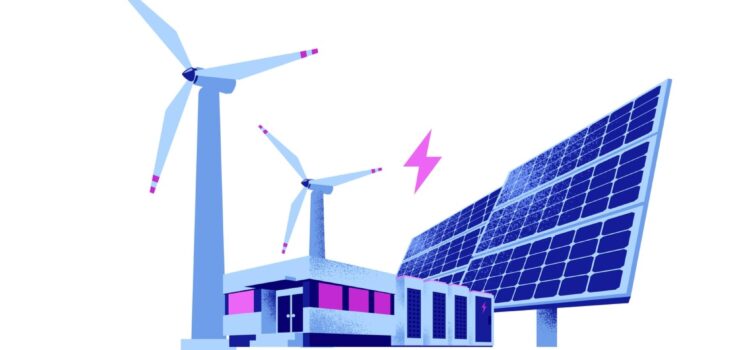
Renewable energy is a term that refers to energy derived from natural resources that replenish themselves faster than they are consumed. This concept is crucial as the world looks for sustainable alternatives to fossil fuels, which are not only finite but also contribute significantly to climate change. Let’s discuss the different types of renewable energy and explore why they are increasingly seen as a viable solution to our energy needs.
Why Renewable Energy Matters
Fossil fuels like coal, oil, and gas have powered the modern world, but they come with significant environmental costs. Burning these fuels releases greenhouse gases, such as carbon dioxide, which are a primary driver of global warming. In contrast, renewable energy sources like sunlight, wind, and water generate power with much lower emissions.
The transition to renewable energy is essential for addressing the climate crisis. By shifting away from fossil fuels, we can reduce our carbon footprint and work towards a more sustainable future. Moreover, renewable energy technologies have become more cost-effective, generating more jobs, and offering a pathway to cleaner, more sustainable energy systems.
Common Sources of Renewable Energy
Let’s explore some of the most common sources of renewable energy and understand how they work.
Solar Energy
Solar energy harnesses the power of the sun, which is the most abundant source of energy on Earth. Even on cloudy days, solar technologies can capture sunlight and convert it into electricity or heat. Photovoltaic panels, commonly known as solar panels, convert sunlight into electricity, while other systems use mirrors to concentrate solar radiation for various applications.
The appeal of solar energy is its abundance and decreasing cost. The price of solar panels has plummeted over the past decade, making them an affordable option for many. Additionally, solar panels have a long lifespan, often lasting around 30 years.
Wind Energy
Wind energy captures the kinetic energy of moving air using wind turbines. These turbines can be installed on land (onshore) or in bodies of water (offshore). Wind energy has been used for centuries, but recent technological advances have made it a more efficient and powerful source of renewable energy.
Despite variations in wind speeds across different regions, the potential for wind energy is enormous, often exceeding current global electricity production. Offshore wind farms offer significant potential, particularly in regions with strong and consistent winds.
Geothermal Energy
Geothermal energy taps into the Earth’s internal heat, extracting it through wells or other means. This heat can be used to generate electricity or for direct heating applications. Geothermal energy is considered a stable and reliable source of renewable energy, with some systems operating for over 100 years.
The main advantage of geothermal energy is its consistency, as it doesn’t rely on weather conditions like solar or wind energy. However, its applications are geographically limited to regions with sufficient geothermal activity.
Hydropower
Hydropower generates energy from moving water, usually from rivers or reservoirs. This form of energy has been a primary source of renewable electricity for decades. Hydropower plants can vary in size, with larger ones using reservoirs and smaller ones using run-of-river systems.
While hydropower is a significant source of renewable energy, it has environmental impacts, particularly when large dams are involved. These can affect local ecosystems and alter river flows. As a result, small-scale hydro projects are often considered a more sustainable option.
Ocean Energy
Ocean energy includes technologies that harness the kinetic and thermal energy of seawater, such as wave energy and tidal energy. Although these technologies are still in the early stages of development, they hold great potential for generating renewable energy on a large scale.
Ocean energy systems offer unique advantages, as they are less intrusive on land and can tap into the vast energy potential of the oceans. However, they require further research and development to become commercially viable.
Bioenergy
Bioenergy comes from organic materials, or biomass, including wood, charcoal, dung, and crops. While bioenergy can reduce reliance on fossil fuels, it must be used cautiously due to potential environmental impacts, such as deforestation and land-use changes.
Modern bioenergy systems often involve dedicated crops or trees, agricultural and forestry residues, and other organic waste streams. Although burning biomass generates greenhouse gas emissions, they are generally lower than those from burning fossil fuels.
The Role of Renewable Energy in a Sustainable Future
Renewable energy sources offer a pathway to a cleaner and more sustainable future. They are abundant, cost-effective, and generate fewer emissions than fossil fuels. As the world transitions to renewable energy, it’s crucial to consider the impact on ecosystems and ensure that these sources are developed responsibly.
By embracing renewable energy, we can reduce our carbon footprint, create more jobs, and work towards a sustainable energy future. This transition requires cooperation between governments, businesses, and individuals to make the necessary changes. Let’s discuss how we can collectively work towards a more sustainable energy landscape.
Is this conversation helpful so far?










